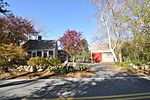Cape Cod Community College
Cape Cod Community College, known locally as "Four Cs", is a public community college in West Barnstable, Massachusetts. It was established in 1961, the second institution to open as part of what is now a 15 community college system in Massachusetts. Cape Cod Community College is the only community college and one of three colleges (along with Massachusetts Maritime Academy (Mass Maritime) in Buzzards Bay, Massachusetts (a Census-Designated Place in Bourne, Massachusetts) and Bridgewater State University's Cape Cod satellite campus) on Cape Cod. It awards Associate in Arts and Associate in Science degrees and various academic certificates in a wide variety of programs. The college offers access to on-campus bachelor's and master's degree programs in partnership with: Bridgewater State University, Boston University, Lesley University, Salem State University, Suffolk University, UMass Boston, and UMass Dartmouth. Cape Cod Community College formally had a partnership with Wheelock College before that merged with Boston University to become the Boston University Wheelock College of Education & Human Development on Boston University's Fenway Campus. Cape Cod Community College is accredited by the New England Commission of Higher Education.The college is home to the Lyndon P. Lorusso Applied Technology Building, a Leadership in Energy and Environmental Design certified facility completed in 2006.
Excerpt from the Wikipedia article Cape Cod Community College (License: CC BY-SA 3.0, Authors).Cape Cod Community College
Scrub Forest,
Geographical coordinates (GPS) Address Phone number Website External links Nearby Places Show on map
Geographical coordinates (GPS)
| Latitude | Longitude |
|---|---|
| N 41.691388888889 ° | E -70.337222222222 ° |
Address
Cape Cod Community College
Scrub Forest 2240
02668 , West Barnstable (Barnstable)
Massachusetts, United States
Open on Google Maps








